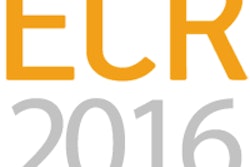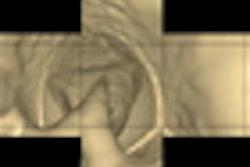Image quality is high and radiation dose is low when the so-called triple rule-out protocol is used with 320-detector-row CT to scan patients with chest pain, according to researchers from Berlin.
Dr. Patrick Hein and colleagues from Charité Hospital in Berlin scanned a small cohort of 30 patients (11 women, 19 men; mean age, 63.2 years) with acute but noncritical chest pain using 320-detector-row nonspiral, nongated chest CT followed by nonspiral, electrocardiogram (ECG)-gated CT angiography of the heart.
Both coronary CT angiography (CTA) and catheter angiography can rule out acute coronary syndrome as the cause of chest pain with comparably high sensitivities and specificities. But these exams can miss other life threatening causes of chest pain such as pulmonary embolism (PE), aortic dissection, or extensive pneumonia, which the so-called triple rule-out CTA was designed to detect, Hein and colleagues wrote in an article published online January 10 in European Radiology.
However, the triple rule-out exam is technically challenging when performed using 64-detector-row CT requiring multiple tailored protocols, the researchers noted.
"The need for a larger amount of contrast material, and, in particular, the increased radiation exposure associated with extending the ECG-gated exam to include the entire chest are points of concern when ... triple rule-out protocols are acquired with 64-slice or dual-source CT scanners," Hein and colleagues wrote.
The 16-cm volume coverage provided by a 320-detector-row CT scanner (AquilionOne, Toshiba Medical Systems, Tokyo) permits the acquisition of nonspiral chest exams and gated coronary CTA exams in a single breath-hold, they said. The study evaluated the feasibility of performing the exams and the resulting image quality at 320-detector-row CT.
"MDCT was performed to diagnose or rule out the most critical underlying conditions, including pulmonary embolism, aortic dissection, coronary artery disease, pneumothorax, and pneumonia," the authors wrote.
Heart rate irregularities were not considered a contraindication; however, patients were excluded for sensitivity to iodinated contrast agents or nephropathy (serum creatinine > 1.3 mg/dL), or if elevated cardiac enzymes or ECG changes indicated the possibility of acute coronary syndromes.
A dual-scan scout exam was performed for planning, followed by a nonspiral, nongated chest exam consisting of three incremental 350-msec data acquisitions obtained at 120 kV and 250 mA, reconstructed at 0.5-mm thickness.
The nonspiral cardiac exam was performed following injection of a total of 90 mL contrast material (Xenetix 350, Guerbet, Paris) injected at 5 mL/sec, with 45 mL injected before the first and second phases, separated by a 30-mL saline chaser bolus.
The cardiac images were acquired at 120 kV and 400 mA and reconstructed with a slice thickness of 0.5 mm. For patients with heart rates under 65 bpm, data were acquired from 70% to 80% of the RR interval; for patients with higher heart rates, data were acquired from 30% to 80% of the RR interval, the authors wrote.
The study team recorded vessel attenuation values of the different vascular territories and evaluated image quality on a five-point scale, one being optimal.
Image quality was diagnostic in all 30 patients, of whom two had irregularly occurring extrasystoles that did not compromise the exam because both were in sinus rhythm at the moment of acquisition. The average heart rate during cardiac CT acquisition was 61.7 ± 10.7 bpm, with heart rates ranging from 46 to 103 bpm.
In all patients it was possible to rule out or diagnose PE, as well as pneumonia, pneumothorax, and other lesions of the chest wall and mediastinum. However, one reader said contrast attenuation in the descending aorta was insufficient to rule out aortic dissection in 14 of the 30 cases, the same studies deemed "inadequate" by the second reader. The average image quality was rated 1.47 by reader 1 and 1.5 by reader 2 on the five-point scale.
Mean attenuation was 467 ± 69 HU in the ascending aorta, 334 ± 52 HU in the aortic arch, 455 ± 71 HU in the descending aorta, 492 ± 94 HU in the pulmonary trunk, and 416 ± 63 HU and 436 ± 62 HU in the right and left coronary arteries, respectively, the authors reported. Radiation exposure estimates ranged between 4 and 7 mSv.
The group diagnosed acute PE (n = 3), chronic PE with right ventricular failure (n = 1), plaque rupture at the aortic arch (n = 1), pulmonary consolidation (n = 1), pleural effusion (n = 2), pericardial effusion (n = 1), noncritical stenoses of the right coronary artery (n = 1) and left anterior descending artery (n = 1), and a complex anatomic anomaly (n = 1).
"Our preliminary results suggest that a 'triple rule-out' protocol can be acquired with 320-slice CT using smaller amounts of contrast medium than in the previous studies investigating this protocol," they wrote.
Use of contrast media might be further optimized by first imaging the pulmonary vasculature, then the heart, and finally the coronary vasculature in a second step, Hein and colleagues wrote. The 320-detector-row scanner also had other benefits over spiral 64-slice CT in the triple rule-out protocol.
"Using a spiral CT mode, the heart is imaged over several heartbeats and misregistration as well as banding artifacts might result due to differences in contrast density," the researchers wrote. "Since with 320-slice the heart can be imaged during a single cardiac cycle, these problems simply do not arise," nor do image quality problems associated with beat-to-beat variation in heartbeat.
Study limitations included a small cohort and, potentially, the lack of an HU-threshold-based bolus-tracking technique. Finally, image scoring might have been biased in favor of the technique because the readers knew they were evaluating a novel CT system.
Initial experience shows that the triple rule-out 320-slice CT protocol has the potential to "provide high contrast attenuation and excellent diagnostic image quality at the same time in the pulmonary and coronary artery system as well as in the aorta," the authors wrote.
In light of the radiation dose reduction compared to other methods, "the scan protocol for 320-slice volume CT should become an important noninvasive imaging option in the triage of patients with acute chest pain," they concluded.
By Eric Barnes
AuntMinnie.com staff writer
February 12, 2009
Related Reading
Flexibility of 320-slice CT boosts cardiac imaging options, October 3, 2008
Prospective gating minimizes dose in 320-slice CTA, August 5, 2008
Fourth-generation MDCT scanners do cardiac differently, July 8, 2008
Coronary CTA cuts costs for chest pain care, February 29, 2008
Radiation dose slashed in 64-slice coronary CTA, February 15, 2007
Copyright © 2009 AuntMinnie.com


















